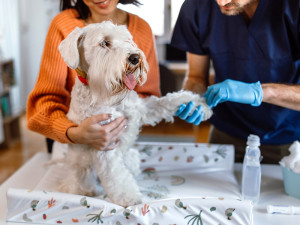Common Household Chemicals Are Linked to Cancer in Dogs, New Study Finds
The problem is worse in warmer areas.

Share Article
When it comes to our loved ones, pets included, no one wants to think about the big C if they don’t have to. But as tough as it is to grapple with, it’s a reality pet parents need to be aware of. According to the American Veterinary Medical Association, opens in new tab approximately one in four dogs will develop cancer at some point in their lifetime. While there’s no foolproof way to keep your pup cancer-free, knowing potential causes is one step toward prevention. In a new study,opens in new tab researchers found that some common household chemicals increase the risk of dogs developing bladder cancer.
A Duke University team attached silicone devices to the collars of 100 dogs to collect chemicals over the span of five days. They tested for 115 chemicals and found that 39 chemicals were detected on the silicone samplers of more than half the pets.
After taking urine samples from the dogs, they discovered that some of the chemicals were connected to markers of bladder cancer. These include flame retardants, which are commonly used on household furniture; phthalates, which add flexibility to plastics; and an air pollutant called anthracene. Dust is most likely the primary way dogs are exposed to these chemicals.
One class of chemicals called PBDEs, which are used in flame retardants, are especially harmful; these were once added in furniture foam, electronics, and other household products. They are no longer used in the United States, but many older objects still contain PBDEs. Additionally, the chemical can linger in environments for decades, according to the Environmental Working Groupopens in new tab, even after products are removed.
Benzyl butyl phthalate (BBP) was also associated with higher levels of cancer. This is a compound found in plastics, including vinyl flooring and artificial leather.
Researchers additionally found that dogs who lived in hotter climates showed elevated levels of cancer markers. This may be because the chemicals more easily turn into gas at higher temperatures.
“When you start to look at these cumulative exposures to chemicals it starts to feel a little daunting, especially if you try to make changes and educated decisions about the things you purchase and take into your home,” Catherine Wise, a co-author of the study, told The Guardian. opens in new tab
Wise recommends doing whatever you can to reduce your pet’s exposure to these chemicals, even if it’s impossible to completely eradicate them from your environment. For one, you can begin using fragrance-free household products, as fragrances often contain toxic chemicals. Using a damp rag or Hepa vacuum to reduce dust can also help. Since the chemicals seem to have a cumulative effect, any small amount of change you can make is an important stride toward protecting your pup.

Sio Hornbuckle
Sio Hornbuckle is the Assistant Editor at Kinship, where they frequently write for the site. As a writer, they specialize in pet news, animal science, and pop culture. They live in New York City with their cat, Toni Collette.
Related articles
![golden retriever dog looks out window]()
Cancer in Dogs: A Primer on Canine Cancers
The word cancer can set alarm bells, turn down the volume by brushing up on cancer basics.
![Two dog chasing each other playfully in a prairie field outside]()
Don’t Worry, But Dogs Can Get Cancer From Sniffing Other Dogs’ Nether-Regions
The gnarly scoop on canine transmissible venereal tumors.
![Closeup of white lab mix dog being pet under the chin by pet parent]()
Can Dogs Get Breast Cancer?
Sadly, yes — one in four dogs will develop mammary tumors — but there's an easy way to prevent them.
![happy woman with a dog]()
How to Keep Your Dog’s Brain Healthy for as Long as Possible
What happens to a dog’s brain when they get older—and how you can slow it down.
![a dog receiving a vaccination]()
A New Vaccine May Be Able to Reduce the Risk of Cancer in Dogs
The Vaccination Against Canine Cancer Study (VACCS trial) is showing promising results.
![Small brown puppy chewing on plastic donut toy.]()
Toys Containing BPA May Cause Obesity in Dogs, New Study Finds
The chemical has been linked to a variety of health problems in animals.





